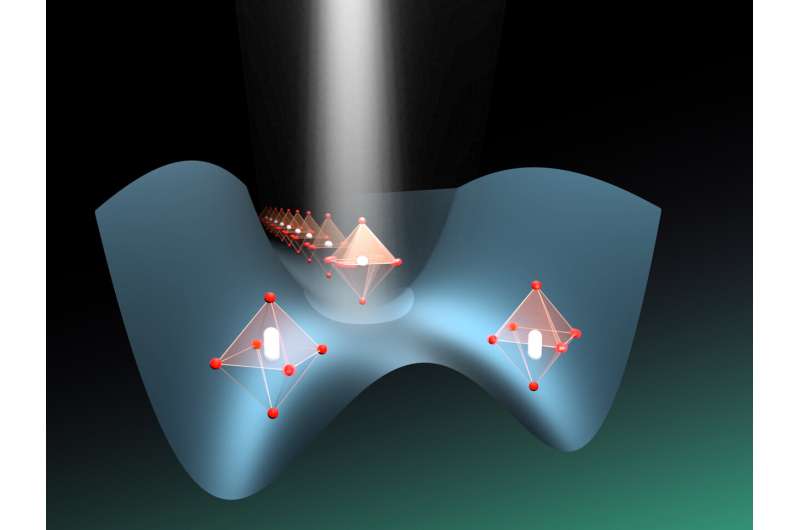Mid-infrared light reduces the fluctuations of octahedral rotations in SrTiO3, allowing the material to transform into a ferroelectric state by shifting the central titanium ion either up or down. Credit: J. Harms, MPSD
Researchers at the Max Planck Institute for the Structure and Dynamics of Matter (MPSD) in Hamburg, Germany and the SLAC National Accelerator Laboratory in the United States have gained new insights into the development of the light-induced ferroelectric state in SrTiO3.
They exposed the material to mid-infrared and terahertz frequency laser pulses and found that the fluctuations of its atomic positions are reduced under these conditions. This may explain the emergence of a more ordered dipolar structure than in equilibrium and of a ferroelectric state when the material is excited with laser pulses.
Mid-infrared and terahertz frequency laser pulses are powerful tools to manipulate the properties of quantum materials through tailored modifications of their crystal structure. Light-induced ferroelectricity in SrTiO3 is a remarkable demonstration of these physics.
Under mid-infrared illumination, this material transforms into a state of permanently ordered electrical dipoles, which is absent in its equilibrium phase diagram. The mechanism underlying this transformation is not understood.
Now a team of researchers at the MPSD and the SLAC National Accelerator Laboratory has performed an experiment at the SwissFEL X-ray Free-Electron Laser to identify the intrinsic interactions relevant to creating this state. The new insight was gained not by detecting the position of the atoms, but by measuring the fluctuations of these atomic positions.
The result provides evidence that these fluctuations are reduced, which may explain why the dipolar structure is more ordered than in equilibrium, and why a ferroelectric state could be induced. The work by the Cavalleri group has been published in Nature Materials.
Ferroelectric materials are characterized by the spontaneous parallel alignment of electric dipoles, leading to a macroscopic polarization that can point in two opposite directions. The pointing direction can be switched by an electric field, enabling the use of ferroelectrics in the digital storage and processing components of modern electronic devices.
Strontium titanate, SrTiO3, is a so-called quantum paraelectric. Unlike many of the ferroelectric materials, SrTiO3 lacks a macroscopic ferroelectric state. Yet, abundant experimental evidence shows that quantum fluctuations of the crystal lattice prevent the long-range order from developing.
Surprisingly, in 2019 the Cavalleri group found that SrTiO3 transforms into a ferroelectric when certain vibrations of the crystal lattice are excited by intense pulses in the mid-infrared. The use of light to induce and control ferroelectricity at electronically inaccessible high frequencies can be envisioned as the key element of future high-speed memory applications.
At the time, the nonlinear response of the crystal lattice was speculated to be the origin of this effect, resulting in the formation of strain that helps the material to become ferroelectric. However, direct measurements of the strain and, even more importantly, of the fluctuations of the atomic positions on the earliest timescales after the mid-IR excitation were lacking.
More information: M. Fechner et al, Quenched lattice fluctuations in optically driven SrTiO3, Nature Materials (2024). DOI: 10.1038/s41563-023-01791-y
Provided by Max Planck Society























